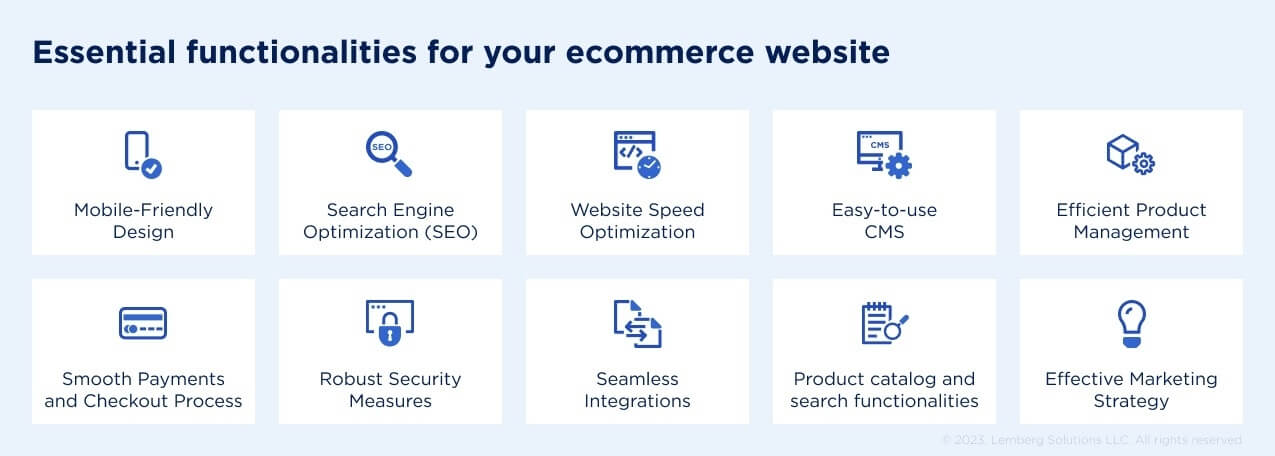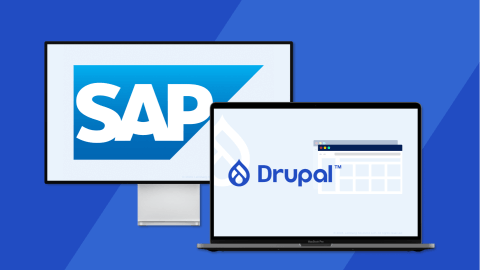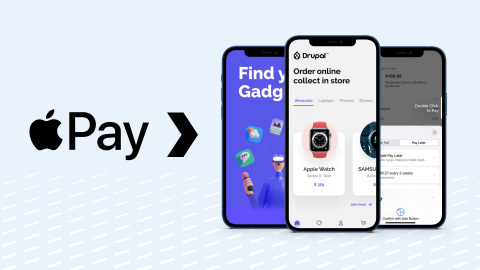Learn how to build an ecommerce website from start to finish in our ten-minute read guide! Lemberg Solutions has 16 years of market experience with a proven track record of building and optimizing online presence for dozens of ecommerce customers. This article shares our tried and true insights, including the step-by-step guidelines for launching your online store. Stay tuned and discover a treasury of our best practices!
What is ecommerce website development?
Ecommerce website development is the process of building a website for selling your products or services online. An ecommerce website has specific features that differentiate it from other types of websites. Among these are checkout functionality, CMS capabilities, SEO-friendly software, email marketing features, discount tools, and others.

What does ecommerce website development involve?
Ecommerce website development involves several steps. Let’s look closer at each of them to ensure you manage the process efficiently:
- Discovery phase. Determine the key features of your ecommerce platform. Also, outline your business requirements and structure the further workflow.
- Create designs. Carefully consider the UI/UX design of your ecommerce website. Pay special attention to the customer services pages and display of your products.
- Choose the platform. There’s a wide range of available ecommerce platforms like Shopware and Drupal Commerce. You need to choose the most appropriate one according to your business needs.
- Develop your ecommerce website. At this point, your development team will build your platform, introducing all required features and functionalities.
- Choose and register a domain. Ideally, the domain name should correspond to your company’s name or be closely connected to the products or services you sell. A good domain name should be short and contain your company’s name. Some great examples of domain names are youtube.com, dailymail.co.ua, tiktok.com, and etsy.com. It can also be helpful to use descriptive keywords or phrases to ensure your target audience finds you quickly. After you’ve chosen your domain and verified it’s appropriate for your business, register it.
- Test and release your ecommerce website. It’s important to have an experienced QA engineer/s on your team to manage this process appropriately. After your platform has been successfully tested and fixed, you can launch your ecommerce website.
What are the essential ecommerce website functionalities?
Take your time to determine your business priorities, consider your preferred customer journey and further development of your ecommerce site. Answering the enlisted questions will help you realize which functionalities to choose while building an online store.
We collected some of the most crucial features and functionalities to help you decide the ones you need for your ecommerce website:

Mobile-friendly design
More than 55% of online purchases take place on mobile devices. This means you need to ensure the mobile version of your ecommerce website has a responsive design and functionality. Don’t forget about user-friendly navigation, mobile payment options, and adaptability for Android and iOS devices.
Search engine optimization (SEO) features
Driving traffic and making your ecommerce website visible to a large number of users is crucial for attracting potential customers. You can integrate a wide variety of SEO optimization features into your ecommerce platform while building an online site.
Check out some of the SEO optimization practices you can introduce:
- Easy website architecture
- On-page optimization
- High loading speed
- Website security management.
Website speed optimization
25% of website visitors won’t wait more than four seconds for a website to load. Thus, it’s crucial to improve your website speed continuously.
For this, you can take the following steps:
- Regularly audit your website
- Prioritize fixes
- Optimize images
- Reduce the number of redirects.
Easy-to-use CMS
CMS enables website administrators to manage and edit website content and always keep it up-to-date. Thus, it’s important to choose a CMS right from the beginning. Connecting your website to an easy-to-use CMS will ensure you don’t need to write any code for content management purposes. For example, you can choose Drupal Commerce or Shopware, feature-rich and easy-to-use ecommerce platforms, for your ecommerce website.
Smooth payments, checkout, and shipping process
Setting up a comfortable payment and checkout process for your customers is another critical consideration while building an ecommerce website. Make sure to provide clients with a variety of payment options like credit cards, direct bank transfers, payment services like Paypal and Apple Pay, and even splitting costs service and local payment methods.
If you’re selling physicals, choose an optimal shipping service for your business.
Robust security measures
Among the most widespread security threats for ecommerce websites are phishing, malware and viruses, cross-site scripting, website attacks, e-skimming, spam, and bots.
To protect your ecommerce website against security threats, introduce the following practices:
- Set up multilayer security
- Use SSL certificates and firewalls
- Install antivirus and antimalware software
- Educate your employees and customers about necessary security measures.
Seamless integrations
Third-party integrations will enhance your ecommerce website functionality and improve user experience. Based on your business needs, choose product you want to integrate. It may be a payment or shipping gateway, inventory management system, invoice and accounting system, CRM, rating and feedback functionality, etc. Then, pick the platform and choose connectors and integrations. After setting up an integration, don’t forget to monitor it regularly and optimize it when needed.
Product catalog and search functionalities
Your products should be easily accessible for users and contain all relevant information potential clients might need.
Follow these simple steps to set up a product catalog:
- Keep your database organized
- Categorize your products
- Provide exhaustive product information
- Personalize your product catalog
- Introduce cross-selling and up-selling
- Use catalog management tools to simplify your daily operations.
Factors to consider when selecting an ecommerce platform
Many ecommerce platforms, like Shopify, Wix, BigCommerce, Adobe Commerce (formerly Magento), and WooCommerce, are available. You can also choose Shopware or Drupal Commerce ecommerce platforms that are now gaining popularity among commerce businesses due to their flexibility and abundance of features.
There are three core factors to consider while choosing an optimal ecommerce platform for your business:
Cost
The majority of ecommerce platforms charge a monthly fee. You’ll have to cover initial and processing costs. Analyze the pricing of each platform thoroughly; however, don’t sacrifice the features and functionalities you need for lower prices.
Scalability
Opt for a cloud-based solution that is capable of scaling. It might be complicated to verify the platform’s scalability. However, there’re some points you should pay attention to. For example, check the load speed of the platform, explore whether it contains frozen pages and 404 errors, and verify its vertical and horizontal scaling capabilities.
Customization
Consider each platform’s customization options to make sure you choose the one that perfectly fits your business needs. Including customer profiles in product reviews and ratings is an excellent example of customization. This way, your potential clients are more likely to gain trust in your product quality. It’s only one example of customization you can use to bring your clients a unique shopping experience.
Choosing the Right Ecommerce Platform
Platform | Cost | Scalability | Customization |
|---|---|---|---|
Drupal Commerce | Open-source (free) | Multi-purpose platform; rich commerce functionality | Advanced customization plugins and modules |
Shopware | Open-source (free with limited features; extend with paid plan) | Modular architecture and the availability of plugins | Custom fields, custom products, custom configuration options, etc. |
| Magento | Open-source (free + necessary integration costs) | Flexibility to add new features, functionalities, and integrations seamlessly | Customizable themes |
| Shopify | Hosted platform (free trial + paid plan) | Advanced scalability using versatile features, e.g. POS payments | Customizable themes |
Ecommerce website development guide: 8 steps to build a store
Ecommerce website development requires a structured and diligent approach. Thus, we decided to outline the following steps to help you ensure building an online store is as smooth as possible for you.
1. Understanding your target market
Understanding your target audience and the market is no guessing game — you should conduct prior research to develop a profound knowledge about your ideal client profile. You can analyze your competitors' clients, use Google Analytics, conduct a survey, research social media, and utilize AI tools.
2. Selecting the suitable platform
Selecting the right ecommerce platform for your retail business is a crucial step for your company's success. Besides cost, scalability, and customization options, you should consider the platform’s overall functionalities to ensure they match your business needs.
3. Organizing product categories
The navigation across your products should be user-oriented. Avoid creating excessively specific categories, and pay attention to the hierarchy you use on your ecommerce website.
It’s crucial to determine the number of category levels and structure them according to your business requirements. Check out an example of a sleek design and concise structure of the product categories on a Drupal Commerce website below.

(Source: https://pamkerrdesigns.com/)
4. Synchronization with internal/external services
If your business is already working with some external services, you can synchronize it with your platform to simplify your daily operations. For example, you could connect your platform to a stock management system.
Among services you could synchronize with your website are ERP, CRM, shipping and delivery, tracking, automation of invoices, price comparison, and other systems.
5. Add functionality for effective marketing
To stand out from the competitors, ensure your customers have a positive experience using your website. Consider adding the comments section, the ability to rate your products/services, provide clients with personal discounts and offers, display similar products, and notify users about new arrivals. Decide whether your clients will have to create their account or entering their personal details will be enough to place an order.
Besides, your website should be user-friendly, have intuitive product listings, filters, order flow and website search.
Review an example of product filtering options on one of Drupal Commerce websites.

(Source: https://pamkerrdesigns.com/)
6. Choose payment system
Try to offer as many payment options as possible — it can help you increase your revenue by 30%. Among potential payment options are credit and debit cards, digital wallets, bank transfers, cash on delivery (COD), mobile payments, buy now, pay later, cryptocurrency, and prepaid cards.
While choosing the payment options, consider your region's most popular payment methods and listen to the customers’ requests.
7. Thoroughly test your website
Testing your website thoroughly is essential while setting up an ecommerce website. Some crucial sections and features to be tested are the home page, search and navigation functionality, catalog of products and services, order processing mechanism, payment function, user data, etc.
8. Leverage data for regular site updates
Track the following indexes: customer lifetime value (CLV), customer retention rate (CRR), shopping cart abandonment rate, customer acquisition cost (CAC), and bounce rate to introduce all necessary changes to your ecommerce website.
Final word
After reading our comprehensive guide, you have all the necessary information on how to create an online store. We outlined the essential ecommerce website functionalities, discussed the key factors to consider while choosing an ecommerce platform, and reviewed a step-by-step guideline for building an ecommerce website.
Lemberg Solutions has vast experience in building versatile ecommerce projects. Among these are e-learning platforms, online shops, marketplaces, B2B portals, subscription-based platforms, crowdfunding platforms, booking and ticketing systems, and self-ordering kiosks. If you have any questions concerning ecommerce website development or would like to build a custom ecommerce website for your business, contact us, and our experts will answer all your questions.

Ecommerce website development FAQs
What is an ecommerce website?
An ecommerce website is an all-in-one online sales channel for your retail business. An ecommerce website is a digital storefront where your clients can find, select, and buy your products.
How do I determine what features my ecommerce website needs?
To determine the feature your ecommerce website needs, focus on your specific business objectives and requirements. Take a look at the following ideas: broad content management capabilities, easy-to-use checkout, SEO-friendly code, integrated blog or articles section, etc.
What are the types of ecommerce websites?
There’re two main types of ecommerce websites: B2B (business-to-business) and B2C (business-to-consumer) ecommerce websites. However, there’re also C2C (consumer-to-consumer), consumer-to-business (C2B), single-brand ecommerce websites, online retailers, affiliate websites, and marketplaces.
What does an ecommerce web developer do?
Ecommerce web developers are responsible for coding ecommerce websites according to the client's requirements. The scope of ecommerce developers’ work depends on the size of the platform and the number of features and functionalities they have to develop.
What is the difference between ecommerce and regular websites?
The availability of online payment functionality is the core difference between ecommerce and regular websites. Ecommerce website visitors can search for products, add them to an online cart, and pay for them without visiting a physical store.



